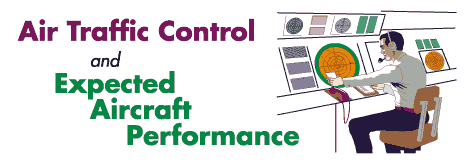![]()
Issue Number 1 : March 1991
|
|
Issue Number 1 : March 1991 |

by Ed Arri
The separation of IFR aircraft by air traffic controllers is based on a number of known factors. One of these factors is the anticipated performance of the type of aircraft, as aircraft of similar type generally climb, descend, and turn in a like manner. Controllers are familiar with the performance of these aircraft and base their instructions on what they expect the aircraft to do. But pilots do not always do the expected. Here are some examples.
In one ASRS report, a heavy air carrier jet [aircraft 1] made a wide left turn after departure, while the second aircraft, also a heavy air carrier of similar type [aircraft 2] departing the same runway made a tight left turn. A loss of separation resulted from the differing performance exhibited by these two aircraft. The controller was busy with 10 to 12 other aircraft and stated that by the time he saw the developing situation, "...the two aircraft were about 4 miles apart, but converging rapidly. I climb[ed] [aircraft 1] to 11,000 feet and attempted to stop [aircraft 2's] climb." The controller also said that "...when the targets converged, I estimated that [aircraft 1] was 1000 to 1200 feet above [aircraft 2]. However I don't think I had the required separation all during this time." The reporter believes that the "...primary cause of this incident was [aircraft 1] turning much wider than expected*, and [aircraft 2] turning much more sharply and climbing much more quickly than anticipated*." (*Emphasis added.)
In another ASRS report, a controller had opposite direction traffic in his sector at FL330 and FL310 with good spacing between aircraft. The higher aircraft (at FL330) was approaching destination and requested a lower altitude. The controller, expecting a normal rate of descent, issued a clearance to the higher aircraft to descend to FL250. This aircraft had over 4 minutes to descend through the altitude of the aircraft at FL310, and to FL290 or below in order to maintain legal separation. (There were 14 or 15 other aircraft also being worked by the controller, thus he was unable to devote full attention to the descending aircraft.) Soon, however, the controller noticed that the aircraft descending out of FL330 had a "...rate of descent [that] was 400 feet per minute, slower than expected." Recognizing a deteriorating situation, he turned one aircraft 20 degrees; however, the turn was not timely enough to prevent a loss of separation and an operational error.
In the conclusion of his narrative, the controller reporter recommended that "...pilots advise if they cannot comply with AIM suggested descent rates." (See Paragraph 270d note below.)
If a standard rate turn cannot be made, or a climb/descent rate is anticipated to be other than normal, notify the controller so that an alternate plan can be used to ensure separation. With the number of aircraft using the ATC system today, good communication and a clear understanding between the controller and pilot on what is expected is absolutely essential for a smooth and safe flight.
| Note: Paragraph 270 (d) of the Airmans Information Manual directs that ..."When ATC has not used the term 'AT PILOT'S DISCRETION' nor imposed any climb or descent restrictions, pilots should initiate climb or descent promptly on acknowledgement of the clearance. Descend or climb at an optimum rate consistent with the operating characteristics of the aircraft to 1,000 feet above or below the assigned altitude, and then attempt to descend or climb at a rate of 500 feet per minute until the assigned altitude is reached. If at anytime the pilot is unable to climb or descend at a rate of at least 500 feet a minute, advise ATC." |
| Reproduction and redistribution of ASRS Directline articles is not only permitted--it is encouraged. We ask that you give attibution to ASRS Directline, to the Aviation Safety Reporting System (ASRS), and of course, to the authors of each article. |